| T O P I C R E V I E W |
| Vlad |
Posted - Aug 03 2010 : 6:54:17 PM
So i got an email from Anatoliy Zilbert. According to him he has information about the mysterious markings A and B(Russian Б) above the serial # on the shoe of the camera.
here are the two original pages:
http://www.bar90.ru/index.php?page=shop.product_details&flypage=tpflypage.tpl&product_id=566&category_id=205&option=com_virtuemart&Itemid=53
and
http://www.bar90.ru/index.php?page=shop.product_details&flypage=tpflypage.tpl&product_id=565&category_id=205&option=com_virtuemart&Itemid=53
According to this if I understand this correctly these letters indicate the class of exposure meter. "A" means it's Class A of the meter according to GOST specification and "Б"(B) means it's Class B according to GOST specifications. And these cameras were made mostly for internal USSR consumption.
Thoughts?
Vlad. |
| 32 L A T E S T R E P L I E S (Newest First) |
| jed |
Posted - Jan 24 2017 : 4:20:46 PM
Hi Vlad,
I've got 9 Kiev 3 A prefix camera. All of them bought from Russia or Ukraine.
I would love to see hight quality pictures of the 1948 "A" Kiev III.
Best,
Jean |
| jed |
Posted - Jan 24 2017 : 4:13:00 PM
Hi Levonsa ;)
Your camera is in between :
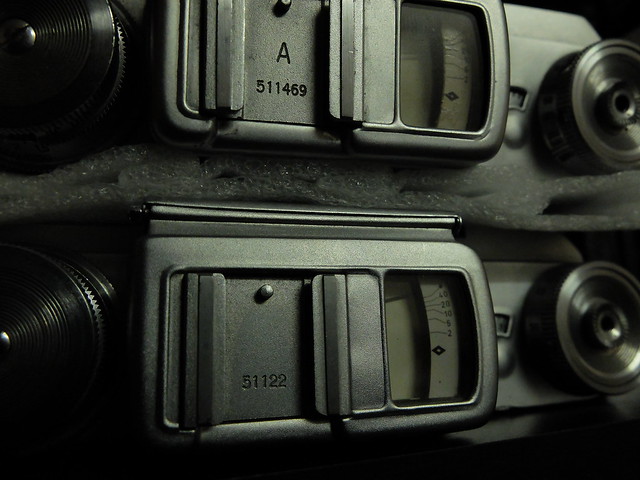 |
| Vlad |
Posted - Jan 24 2017 : 11:52:21 AM
Wow that is early! Another reputable Arsenal collector was also telling me that the A possibly meant export camera with lightmeter calibrated for western standards/precision. And Б was domestic as you mostly only find them on the old USSR territory and A is mostly found abroad. Any comments on that?
Also Yuri and I had established from a serial # list that we collected that Б (B) only existed in 1954. If anyone can refute that it would be very interesting!
Thanks,
Vlad |
| levonsa |
Posted - Jan 21 2017 : 1:38:52 PM
Hi !
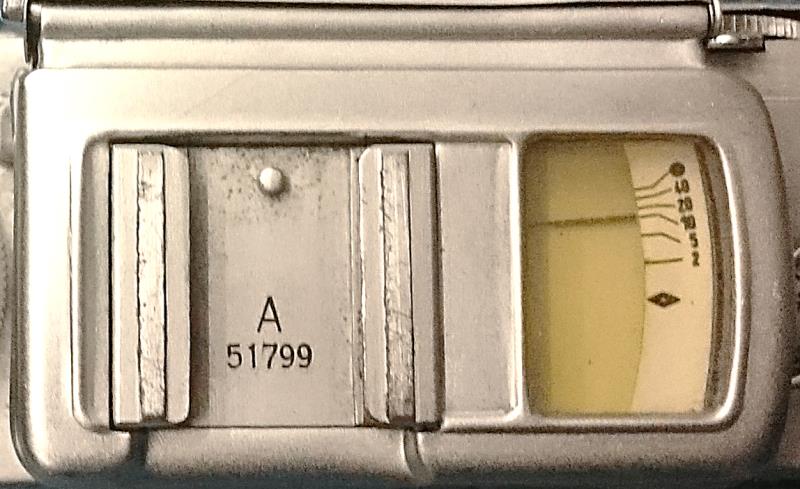
http://www.ussrphoto.com/UserContent/2112017_DSC_0001.JPG
|
| Jacques M. |
Posted - Jan 20 2017 : 12:03:21 PM
quote:
Originally posted by fedka
Maybe the serial number engraver was bored and introduced letter A for fun, and then made it "square" A, and was bored still, started adding B, and then retired (or got arrested).
Ha ha!
Finally, the track of the lightmeter is perhaps not the only one. On re-reading the thread, I have compared with the s/n in the wiki. And we have two Kievs which are "out of the scale": the III s/n A480075 owned by Alexander (we already discussed about that camera, if I remember), and the A480123 which is a Kiev II. A mistake in engraving? Or the lightmeter is not the explanation?
This "A" remembers me too a jump in numbering. Fed did the same in 1960 when there was a "collapsing" between their Fed 2 and Fed 3 numberings... But is it the problem here?
Amitiés. Jacques. |
| fedka |
Posted - Dec 28 2016 : 12:03:31 AM
Vlad,
Sorry, not ready for the original theory.
The meters were, of course, calibrated at the factory, using some sort of reference light. Determining accuracy and precision (not the same thing, can explain if needed) can be done using special instruments and procedures, and certainly the meters, just like the shutters or lenses, were found of higher and lower performance.
But once again - my main question - if they indeed differentiated between meter grades - why not bring it up in the manual, or passport (where other important parameters, like resolution of the lens, are recorded). What is the point of grading meters if nobody knows about it?
Interestingly, Victor Suglob's book, as comprehensive as it is, does not even mention these letters.
Maybe the serial number engraver was bored and introduced letter A for fun, and then made it "square" A, and was bored still, started adding B, and then retired (or got arrested).
quote:
Originally posted by Vlad
damn!  . Thanks for doing this work Yury! So what about circling back to precision as to original Anatoly Zilbert's theory? As the GOST specification is from early 60s and these Kievs are from 1950s, it does cast a doubt but I wonder how does the precision gets measured in order to classify the meters? . Thanks for doing this work Yury! So what about circling back to precision as to original Anatoly Zilbert's theory? As the GOST specification is from early 60s and these Kievs are from 1950s, it does cast a doubt but I wonder how does the precision gets measured in order to classify the meters?
Vlad
|
| Vlad |
Posted - Dec 27 2016 : 11:07:49 PM
damn!  . Thanks for doing this work Yury! So what about circling back to precision as to original Anatoly Zilbert's theory? As the GOST specification is from early 60s and these Kievs are from 1950s, it does cast a doubt but I wonder how does the precision gets measured in order to classify the meters? . Thanks for doing this work Yury! So what about circling back to precision as to original Anatoly Zilbert's theory? As the GOST specification is from early 60s and these Kievs are from 1950s, it does cast a doubt but I wonder how does the precision gets measured in order to classify the meters?
Vlad |
| fedka |
Posted - Dec 27 2016 : 11:03:43 PM
Took apart 3 cameras, tired and disappointed.
1954 "B" with GOST dial
1954 "A" with GOST (square A if anybody cares)
1953 "A" with DIN
All 3 have the same cell, glass on a metal substrate. One wire is soldered to the front of the cell and another - to a flat (leaf) spring that makes contact with the metal substrate. They scratched the substrate to make a better connection.
We need new theories...
Pictures below, see file names
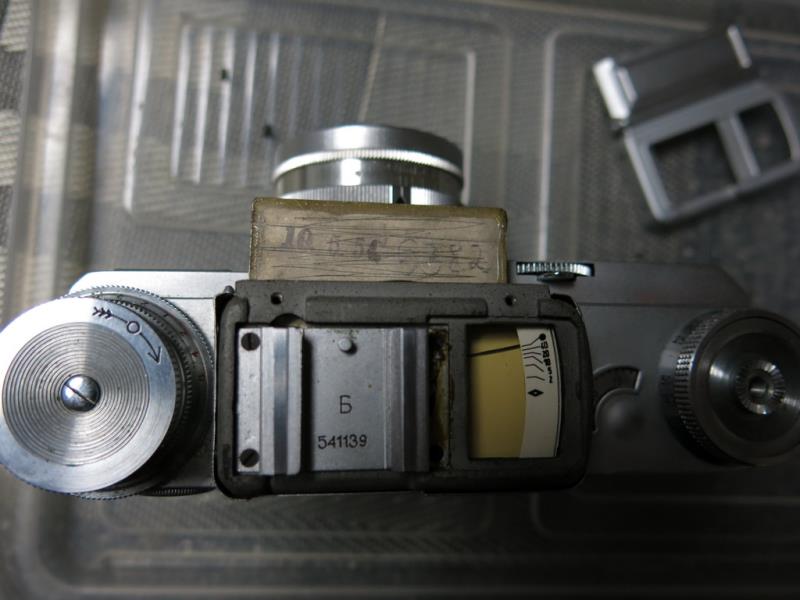
http://www.ussrphoto.com/UserContent/27122016_B_GOST.JPG
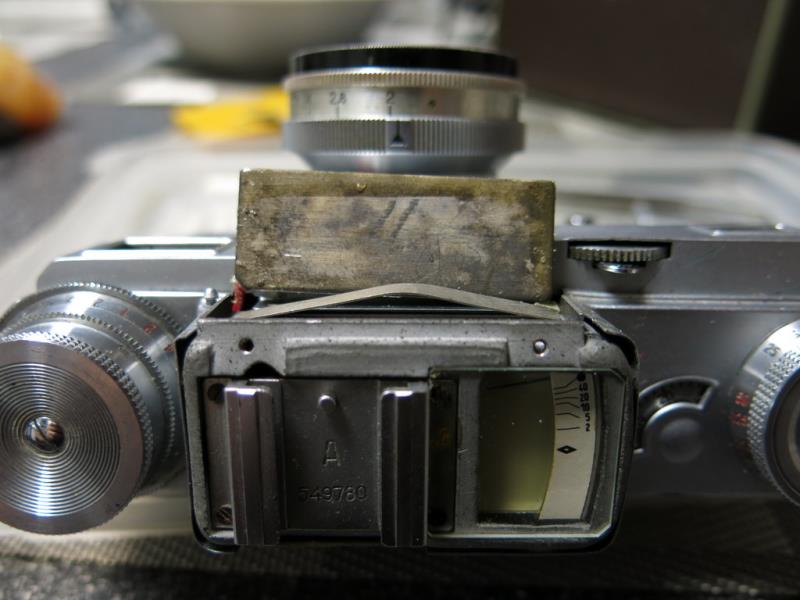
http://www.ussrphoto.com/UserContent/27122016_A_SQ_GOST.JPG
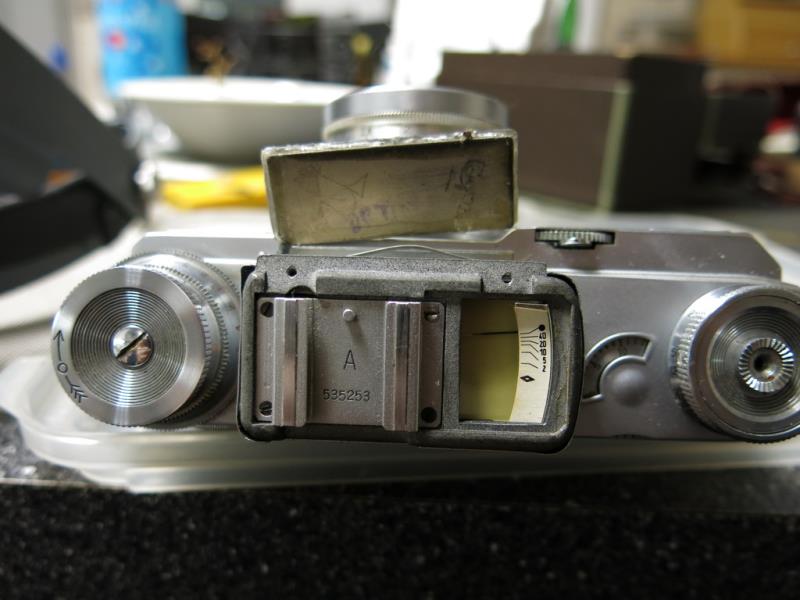
http://www.ussrphoto.com/UserContent/27122016_A_DIN.JPG
|
| Vlad |
Posted - Dec 27 2016 : 4:49:42 PM
Then my theory has flaws  Thanks Jean! Thanks Jean! |
| jed |
Posted - Dec 27 2016 : 4:47:41 PM
Vlad,
You're right last A camera is around mid-56. They started in 1951 (I own 2 cameras). I believe each year some cameras were released without letters (I own cameras from 1951, 52, 55, 56). |
| Vlad |
Posted - Dec 27 2016 : 4:15:38 PM
or 56 is the latest we've seen letters.. |
| Vlad |
Posted - Dec 27 2016 : 4:14:53 PM
Steve, that is a very logical conclusion!
Jean, so to answer your question if to follow Steve's logic Arsenal didn't account for the possiblity of using the lightmeters in parallel so they may have only started doing so some time in 1952. So if it makes sense once they started mixing in the Arsenal light meters and making parallel production they would mark them A or B and anything before that would by default have a Zeiss meter. And it would go on until 54 and then anything after 54 would not have letters, by default would have Arsenal meter. Question is are there 53 Kievs without the letter? That may disprove my hypothesis if there are. 
Cheers,
Vlad |
| jed |
Posted - Dec 27 2016 : 4:04:31 PM
Hi,
Interesting but what about Kiev III without A or B ? Also I own a 1952 Kiev III with a 'DIN' meter and the selenium part is of Ukrainian manufacture (see date stamped :)
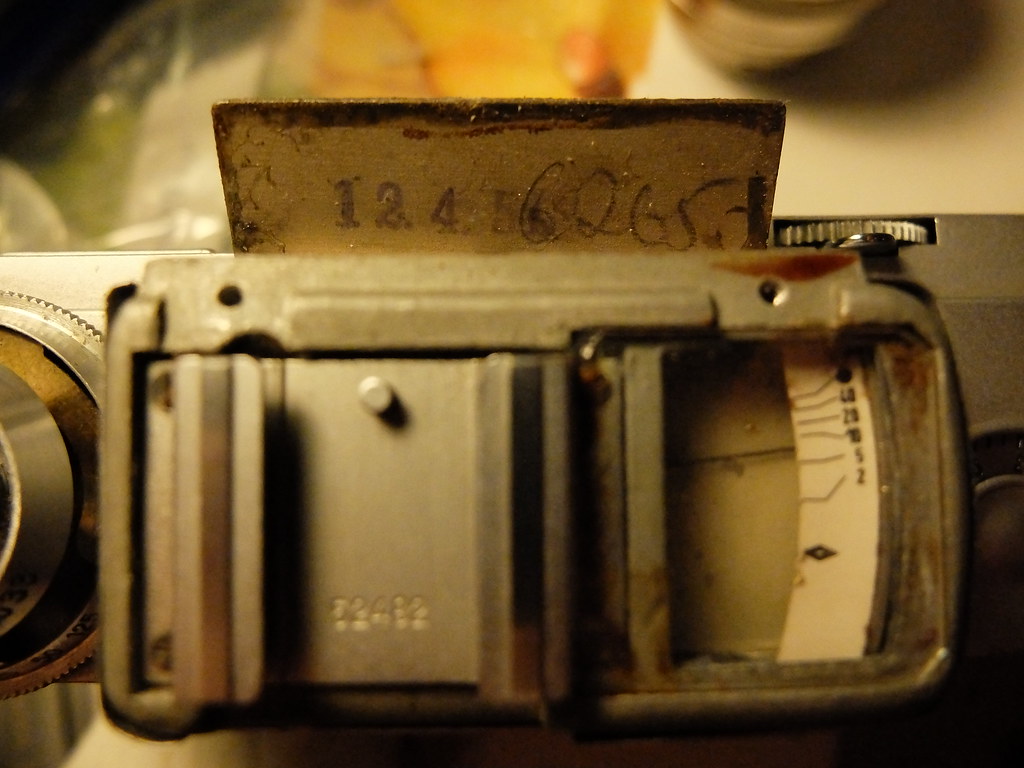 |
| fedka |
Posted - Dec 27 2016 : 2:26:32 PM
Steve, I like this theory. I am not ready yet to take the cameras apart, but who knows.. maybe I will if this bothers me bad enough.
Having different "moving coils" would explain the markings.
It is safe to suggest that A and B are related to the meter, since they only exist on the Kiev III (metered camera) and does not exist on Kiev II.
Another point that supports your theory - this letter carries some information, so who is the target of this information? Probably not the user, since the manuals do not cover this. This leaves service people, so they would know what parts to order or what procedure to follow for repair, and that they would not mix the "coil", variable resistor, and the Selenium cell between the Zeiss and Arsenal types. All 3 parts (and maybe more, like the front plastic diffuser) have to be from the same design type.
quote:
Originally posted by SteveA
Hi, the only way really would be to dismantle and see if there is any difference in construction of the meter. I believe until the mid-50's Zeiss meter components were being used up alongside Arsenal produced copies. The Zeiss meter cells generally had a cellophane wrapping to protect the Selenium, and were not soldered but captured in a metal frame, to which the wire was soldered. I believe there were fundamental differences in the design of the Zeiss and Arsenal moving coil meter units. Maybe the A or B relates to the type of cell and moving coil fitted?
Cheers,
Steve
|
| SteveA |
Posted - Dec 27 2016 : 1:32:19 PM
Hi, the only way really would be to dismantle and see if there is any difference in construction of the meter. I believe until the mid-50's Zeiss meter components were being used up alongside Arsenal produced copies. The Zeiss meter cells generally had a cellophane wrapping to protect the Selenium, and were not soldered but captured in a metal frame, to which the wire was soldered. I believe there were fundamental differences in the design of the Zeiss and Arsenal moving coil meter units. Maybe the A or B relates to the type of cell and moving coil fitted?
Cheers,
Steve |
| fedka |
Posted - Dec 25 2016 : 5:47:50 PM
I know this is an old thread, but the cameras we are dealing with are also old, so let me try re-open it. maybe we got new knowledge by now?
I have Kiev III with a "B", from 1954, it happened to have an original papers, manual and passport.
I carefully examined both, not a word or mentioning about the serial number letters.
So, let's say Arsenal cared about meter accuracy and grades, so much that they went through a hassle of engraving a letter on the accessory shoe. So it meant something reasonably important.
Should something this important be mentioned in the documents that came with the camera? If not, why bother? I know, the USSR was not following common sense all the time, but defense factories and their engineers did make sense.
A long shot would be to check the pricing for the Kiev III with A and B. I, unfortunately did not find any price on mine.
At some point I thought that maybe A and B has something to do with the DIN and GOST on the meters, but that does not work. In 1954 both A and B were in GOST.
Yuri
quote:
Originally posted by jed
quote:
Originally posted by uwittehh
Michel,
by the way, look at the different meter scales. They are the same on A engraved Kievs, but different on the B engraved one :-)
Ulrich
http://fotos.cconin.de
Hello, my 1954 kiev III 'B' camera has the same scale like Michel's 'A' Kiev III...
|
| jed |
Posted - Aug 09 2010 : 07:39:15 AM
quote:
Originally posted by uwittehh
Michel,
by the way, look at the different meter scales. They are the same on A engraved Kievs, but different on the B engraved one :-)
Ulrich
http://fotos.cconin.de
Hello, my 1954 kiev III 'B' camera has the same scale like Michel's 'A' Kiev III... |
| dee |
Posted - Aug 08 2010 : 09:51:14 AM
I have two Kiev 3a with ' A ' above the number - both 1956 .
Is there any significance to this ?
I bought them because I like the uncluttered accessory shoe .
dee |
| dee |
Posted - Aug 08 2010 : 09:50:41 AM
I have two Kiev 3a with ' A ' above the number - both 1956 .
Is there any significance to this ?
I bought them because I like the uncluttered accessory shoe .
dee |
| Michel |
Posted - Aug 07 2010 : 02:50:19 AM
Yes, okynek, you're right.
And, as you noticed, it is a "square" A.  |
| okynek |
Posted - Aug 06 2010 : 8:16:23 PM
I have same kind scale for "A" and "B":
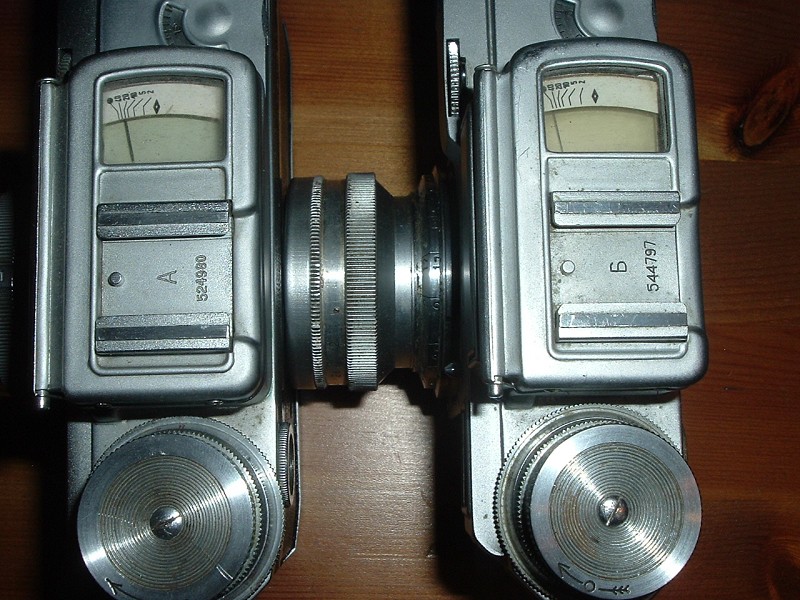
http://www.ussrphoto.com/UserContent/682010_DSCF0250.JPG
Check this Kiev on eBay:
http://cgi.ebay.com/KIEV-3-III-Russian-USSR-35mm-camera-/320558917535?pt=Film_Cameras
It has serial no. with "A" but scale as on "B"
|
| Michel |
Posted - Aug 05 2010 : 5:47:11 PM
Ulrich,
Yes !
That's the reason why I post the photos.
Michel. |
| uwittehh |
Posted - Aug 05 2010 : 2:09:23 PM
Michel,
by the way, look at the different meter scales. They are the same on A engraved Kievs, but different on the B engraved one :-)
Ulrich
http://fotos.cconin.de |
| okynek |
Posted - Aug 05 2010 : 1:45:44 PM
GOSTs have to be revised after some time. This means that GOST for tolerance of light meters may exist in 1954(production year of the lettered cameras) and then GOST was revised in 1968 and 1979. So letter may belongs to meter, not to the camera, but that also means that all Kiev 3 from some period in 1954 have to had this letters. Is it coincide with our database?
P.S. GOST-ghost something spooky and mysterious, like in real live it was.    |
| Michel |
Posted - Aug 05 2010 : 1:33:41 PM
If this can bring "water to the mill", here are three photos of three Kiev III cells :
As you may see, the graduations are somehow different…
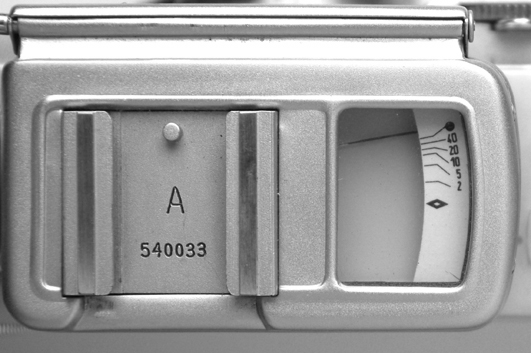
http://www.ussrphoto.com/UserContent/582010_sharpA.JPG
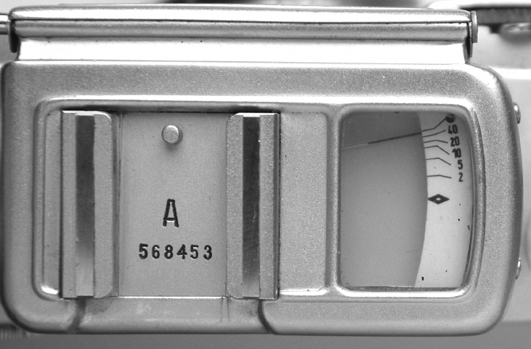
http://www.ussrphoto.com/UserContent/582010_square A.JPG
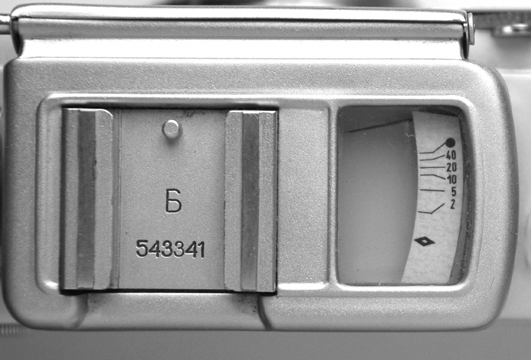
http://www.ussrphoto.com/UserContent/582010_b.JPG
Michel.
|
| Vlad |
Posted - Aug 05 2010 : 12:41:47 PM
Good point! But I would assume once GOST was implemented when these Kievs were made, the classification would be the same no? Maybe they found out later that they don't have to stamp these on every model, so they stopped? I can ask Anatoliy if there are earlier examples.
Vlad. |
| okynek |
Posted - Aug 05 2010 : 11:01:37 AM
<quote>This long lasting mystery is probably solved.<quote>
Not to fast yet 
The two last digits in GOST numbering are a year of issue. As you can see the year of GOSTs above are 1968 and 1979, much later then Kievs with A and B was produced. And what about Kievs without letters? I would expect that by GOST (Government Standard) rules all the cameras with light-meeter should have some kind of letter. Other way cameras with letters should be some way different from standard cameras without letter.
I like the idea, I hope that it uncover the mystery, but IMHO more prove needed. |
| Michel |
Posted - Aug 04 2010 : 05:52:53 AM
Hi Juhani,
If I understand your post, you mean that "B" are more common than "A".
I'm not so sure : I have a (very) small database of Kievs III, including "A", "B" and "square A".
I see that on a survey of 46 cameras, only 17 are "B" ( and all of them from 1954) and 29 are "A" or "square A".
Of course, 46 cameras is not statiscically significant, but nevertheless I think that "B" are more uncommon than "A" at least in private collections or eBay.
Any comment ?
Best regards,
Michel. |
| cedricfan |
Posted - Aug 04 2010 : 03:35:11 AM
If I am correct the B is more common, so A class was rare to get in domestic market...
Best regards,
Juhani |
| Michel |
Posted - Aug 04 2010 : 02:58:37 AM
So !
This long lasting mystery is probably solved.
Good news!
And thanks to Anatoliy and Vlad.
BUT, may I ask another question : what about "square" and "sharp" A ?
Sorry for asking again…
(As I was fired the last time I evoked this problem, I erased all my posts about it  ) )
Cheers,
Michel.
|
| Vlad |
Posted - Aug 03 2010 : 11:38:08 PM
He sent me a follow-up email with these exerpts from various light meter manuals:
Фотоэкспонометра «Свердловск-5».: "Точность экспонометра по ГОСТ 9851—68 — класс Б".
Фотоэкспонометра «Свердловск-4».: "Экспонометр настроен по ГОСТ 9851-79 класс А с экспонометрическими постоянными...."
Фотоэкспонометр "Ленинград-10": "Экспонометр отвечает требованиям ГОСТ 9861-68 к экспонометрам высшего класса А"
Фотоэкспонометр "Ленинград-8": "Экспонометр соответствует ГОСТ 9861-79, по точности - классу Б"
Lightmeter "Sverdlovsk-5": "Precision of lightmeter per GOST 9851-68 - Class B(Б)"
Lightmeter "Sverdlovsk-4": "Precision of lightmeter per GOST 9851-79 Class A with metering specs...."
Lightmeter "Leningrad-10": "Precision of lightmeter per GOST 9861-68 for lightmeter of highest Class A"
Lightmeter "Leningrad-8": "Precision of lightmeter per GOST 9861-79, with precision of Class B (Б)"
So we can see that how Anatoliy arrived to this conclusion going by this system the A and Б stamps on Kiev III can describe the same meter classification.
Cheers,
Vlad.
|
| okynek |
Posted - Aug 03 2010 : 9:27:15 PM
Very probable explanation. Make a lot of sense. And what would be difference between Class A and B? Is Class A better then Class B? |
